16 Strategies to Stretch Your Food Budget
If soaring food prices are getting you down, help is on the way! Here are some basic saving strategies, practical solutions, and novel ideas to stretch your food budget—and make your life easier. Granted, one of these strategies on its own is not likely to make a huge difference. But lots of small strategies working together—that’s the way to see huge results.
1. “Grate” Savings
You pay a lot to have someone else grate your cheese for you—at least twice the price of buying cheese by the block. Currently, at my supermarket, cheese in blocks runs from about $2 to $2.50 a pound for the store brand to about $5.00 a pound and more for name brands. The very same cheeses, pre-grated, run almost exactly double across the board, $4 to $10 a pound. Here’s the tip: Grate it yourself. It will stay fresher, and you’ll save money, too.
Why Your Packaged Shredded Cheese Doesn’t Melt Right
Commercially grated or shredded cheese comes with an added ingredient like potato starch or modified cornstarch to prevent “caking” or “clumping.” Well, guess what? Those anti-caking ingredients inhibit melting, too. Now you know why pre-grated or shredded cheese doesn’t seem to always melt as readily, often leaving an odd thickened texture.
2. Keep Breakfast Cheap
Breakfast is one meal that can easily be simple and take up a very small portion of your food budget. Foods like eggs, oatmeal, and toast can all be cheap but also filling ways to start your day.
Bake muffins, quick breads from scratch. Skip the mixes and other superficial time-savers.
Breakfast cereals are pricey! Make sure you buy boxes of cereal ONLY when they are authentically on sale, or you have use-worthy coupons.
3. Breakfast for Dinner
Once a week or so, consider having breakfast for dinner. Kids love this, and so will your food budget. A meal of eggs, pancakes, or waffles and juice is nutritious, meatless, and super cheap (relatively, so).
Get creative with leftovers and watch how far you can stretch your food dollars. Those leftover baked potatoes from last night’s dinner will make fabulous hashbrowns or fried potatoes to go with scrambled eggs.
4. Eat the Sales
Plan your meals around what’s on sale, and you’ll chop your food costs—by up to 50% or more. And when you can load up on super sale items to last until the next time they go on sale. Nearly every grocery store or supermarket publishes a weekly sales ad flyer—and posts it online. What a handy tool to help with meal planning. Eat the sales to stretch your food budget!
5. Double-duty Ingredients
There was a time when if a recipe called for half an onion, I’d toss the other half in the fridge where it would sit until it was over the hill, and I could toss it out guilt-free. What a waste!
The solution is pretty simple: Plan ahead. I know ahead of time that I’m using the other half of that onion for another recipe later in the week, so I wrap it tightly in plastic wrap and store it in the refrigerator.
The same goes for half a pepper, partially used cans of beans, or ground beef. Generally, splitting one portion into two meals is a great way to make your food budget stretch—provided you have at least an idea for how to use the other half!
6. Meal Plan
Not planning meals ahead of time is the best way to blow a lot of money on eating out, picking up, and driving through. It takes time and effort on the front end to plan out meals for a whole week or two, but in the end, saves so much time and money. No more wondering, “What’s for dinner!?
7. Found Food
You know that last slice or two of bread, the hard-as-a-rock end of baguette or crusts you cut off the kid’s sandwiches? Often they’re dry, past prime, and not enough to make anything respectable, so into the garbage they go. Well, not so fast.
Making your own breadcrumbs is as simple as whirring a few slices in a food processor or blender until the bread becomes fine-textured crumbs. Another option is to use that cheese grater!
Bake the crumbs on a baking sheet; 350° F stirring every 10 mins. Depending on how much moisture you’re dealing with and the depth of the crumbs, it should take about 20 to 30 mins.
Make Italian-style seasoned bread crumbs by adding 1 teaspoon dried Italian seasoning blend to every 2 cups to crumbs before baking. Cool completely then store in an airtight container.
8. Veggie Bouquet
Store asparagus in the fridge in a glass of water (like cut flowers in a vase). It will stay fresh for a couple of weeks. Works with celery, too. Discover every possible way you can stop throwing away precious food dollars in the form of rotten produce.
9. Soften Butter in a Flash
Keeping butter out on the counter for an hour isn’t exactly ideal for a tight schedule. Here are three ways to soften butter quickly:
- Drop a still-wrapped stick of butter into a small zip-top bag, seal it shut and place it into a bowl of warm tap water for about 5 minutes or until soft.
- Grate it with a cheese grater and a cold hard stick of butter turns into fluffy soft butter.
- Flatten it with a rolling pin (but put it in a plastic bag first) for spreadable, mixable butter in a pinch.
- Cut that cold stick of butter into small cubes, about 1/2-inch, spread the out and they’ll be soft in about 10 minutes.
10. Longer Lasting Tomatoes
Store tomatoes stem end down to keep them from spoiling as quickly. This prevents air from entering and moisture from exiting the scar where the tomato once attached to the vine. Storing them at room temperature rather than in the fridge also makes tomatoes last longer.
11. Beef in Bulk
Buying the “family size” package of ground beef will chop the cost per pound significantly and really stretch the food budget! But if you use it up faster just because you have more, there go the savings. When you get home you need a reliable way to divide the meat into usable portions.
If a recipe is filling and tastes great with just one pound of ground beef, why use 1 1/4 pounds? If you try to eyeball that amount, you can easily be off by a quarter pound.
Investing in a reliable kitchen scale makes lots of sense. You don’t need anything fancy, just make sure to purchase one that can be easily cleaned. I have this digital multifunction food scale.
Vacuum seal portions before placing them in the refrigerator or freezer. Or wrap portions tightly with plastic wrap, then place them into freezer-type bags that are sealed completely with excess air pushed out.
12. DIY Buttermilk
To make buttermilk when there’s none of the real stuff in the fridge, add a tablespoon of vinegar or lemon juice to a cup of regular or 2% milk. Allow to sit for 10 minutes while it thickens, slightly.
The mixture won’t get as thick and creamy as buttermilk, but it will help create fluffy pancakes and quick bread just the same. Your recipe will turn out great and you’ll have saved yourself an expensive trip to the market. You know the routine—you run in to grab milk and come out with $65 worth of things you didn’t know you needed. Right?
13. Creative Marinade
Tenderize cheaper cuts of meat by marinating them in cola. Several hours ahead of time, place the meat in a bowl and cover with cola (Coke or Dr. Pepper works, too). Add 2 tablespoons soy sauce and 1 teaspoon garlic powder.
While broiling (or grilling), brush the cola marinade over the steaks. This is a great way to use up cola that has gone flat and avoids buying a $6 bottle of prepared marinade.
14. Bye bugs
To protect dry staples such as flour, meal, grits, pasta, and rice from contamination, pop dry bay leaf or two into the container. This won’t affect the taste, but it will prevent pesky bugs from ruining these products.
15. Weigh Bagged Produce
Use the handy scale in the market produce department to weigh pre-weighed bags. For example, if you’re buying a 5-pound bag of potatoes, weigh several bags. The bags will vary and you’re sure to find one that’s 5.5 or heavier, for the same price!
16. Leftover buffet
Take the remains of the week’s meals and serve them for dinner, buffet-style. Need to pad the offerings? Raid the fridge for veggies and dip, make a green salad, or toast some crusty bread. Keep this idea handy. You just might decide to make Leftover Night a regular weekly occurrence!
Question: Got a great tip up your sleeve for how you stretch your food budget? Please share in the comments area below!
Everyday Cheapskate participates in the Amazon Services LLC Associates Program, an affiliate advertising program designed to provide a means for us to earn fees by linking to Amazon affiliated sites.






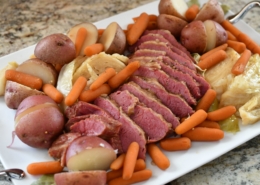

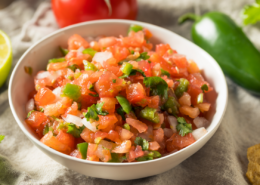
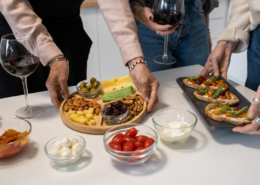

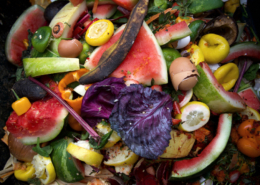
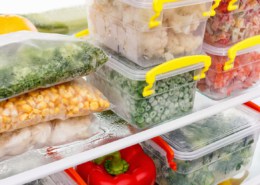



1. You are so right about grating your own cheese!
2. If you only need half an onion, put the other half in an empty pickle jar in the fridge. It can easily last for a week or two and the onion smell won’t affect other foods.
3. I call Leftover Night the “Festival of Leftovers”. Somehow this makes us smile and be good sports about it. 🙂
Thanks Mary!!
Wrap your celery in alfoil – it will keep for weeks. I have no idea why this works – but it does!
For years, when bread was past its fresh stage for sandwiches, it went into the freezer until I had enough to grind up for bread crumbs. Like Janice, leftover pepper and onion went into the freezer chopped and ready for another meal. When my husband was in college in the 1970’s and we were married with a 3 year old son, we had to make every penny count and we could afford to waste food. Now 50 years later I find that those old habits are still with me.
you can also take different pieces of leftover bread and cut up for a dessert! bread pudding – delish
When I first moved into where I live now, I had a problem with spiders in the kitchen cabinets. I put bay leaves on all the shelves and haven’t had a spider or any bug problem since.
Since I only go to the grocery store every other week now, I’ve been experimenting on how to make fresh bananas last since my breakfast is usually yogurt and bananas. The winner so far is buying slightly green bananas, separating them, and wrapping the stem end in foil. It really stopped them from ripening quickly, and when fully ripe they lasted even longer in the fridge.
Thank you Bonnie.
I was told to use plastic wrap but it’s hard to stay on. I have to put a rubber band around it. I will definitely try your method!
: )
When ever I make a beef or pork roast or beans in the crockpot, I strain the broth, remove the fat and freeze it as stock for a future pot of soup. Same goes for any can of broth or veggie when I don’t use the whole can. Any leftover veggies that are not enough to serve for another meal go into a freezer bag that’s used future soup.
I grew up in the 50s with regular meals called “egabrag” – – “garbage” spelled backwards (the first “g” is soft, like a “j”) . You called it “Leftover buffet”; my kids still recognize egabrag as it’s proper name!
I do the weighing trick with rotisserie chicken.. there’s often quite a difference in weight between the chickens, and they’re all the same price…
I’ve started doing the same thing with pretzel bits, whirl them up in the food processer and use like bread crumbs.
I made a meatloaf and used tortilla chips crumbs whirled up as a sub for bread crumbs and now that has become our favorite version of meatloaf…
I tell the kids…when you throw food away you might as well shake your piggy bank into the trash can!
I never thought to use tortilla chip crumbs in meatloaf, but it sounds delicious. Thanks for the tip!
I love all your tips! If I have leftover onion or pepper I will not be able to use soon, I dice them up and put on the small 100 calorie zip lock bags and then place those in a larger freezer safe zip lock. When I need onions or peppers for chili or other dishes, I grab a bag out of the freezer and toss it in. Works great and saves time too since it was prechopped.[
Yes! Me too. I do the same with bell peppers and jalapenos. Someone gave me 4 bunches of celery (yay!)—Some I wrapped in foil and some I chopped and froze for soups or stews. The aluminum foil really works very well with fresh celery…it lasts for weeks.